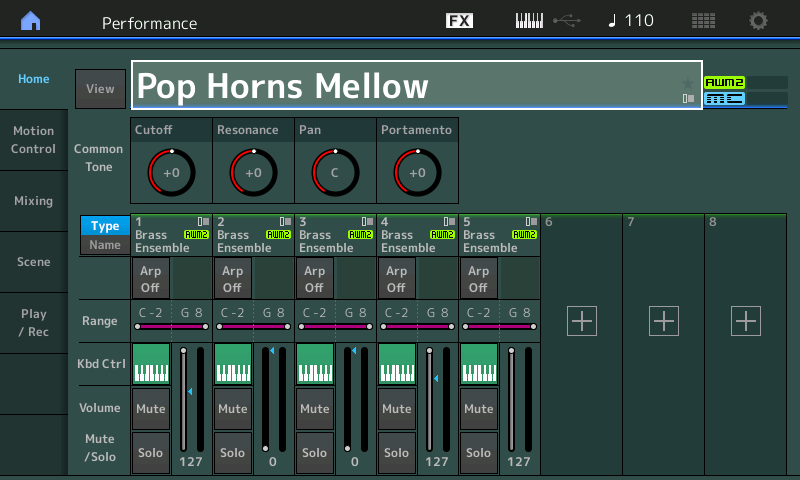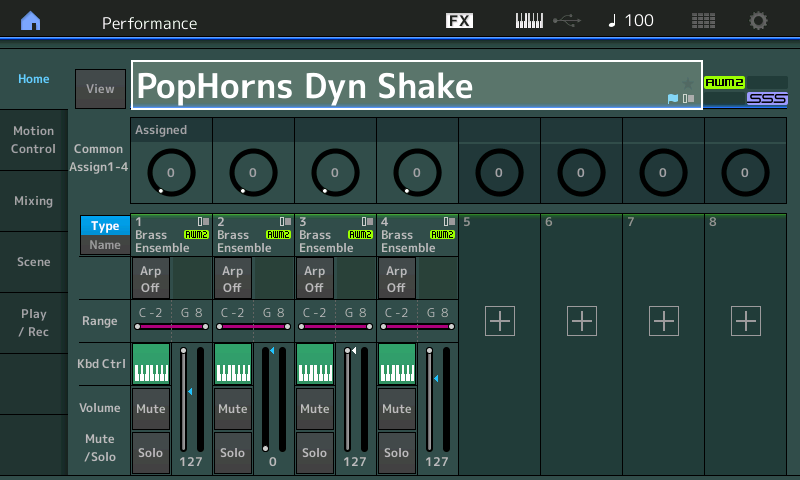this is for Bad Mister. two questions here. with your help on this forum I finally know how to layer performances. got my string section the way I like it. Phil, on your post to nstuffmusic part #2 for the Montage, you put together a horn section that is blowing me away, just what I am searching for. any chance, please could you give me the layer of performances that I could copy on my modx6. would greatly appreciate it. secondly, when I go to category search, then hit sub, the R&B hip hop ,jazz world, rock and pop and electronic all show blank spaces. is there something wrong with my keyboard or are those areas blank. thank you in advance.........Larry
with your help on this forum I finally know how to layer performances. got my string section the way I like it. Phil, on your post to nstuffmusic part #2 for the Montage, you put together a horn section that is blowing me away, just what I am searching for. any chance, please could you give me the layer of performances that I could copy on my modx6. would greatly appreciate it.
I’m not in my studio this week (on the road traveling) but when I get back, I’ll look into what I did in that video and post it for MODX.
secondly, when I go to category search, then hit sub, the R&B hip hop ,jazz world, rock and pop and electronic all show blank spaces. is there something wrong with my keyboard or are those areas blank.
No, nothing wrong... There is not something in every category... those Sub headings are for users to utilize when categorizing their own custom Performances, if you desire. As you create your own Arpeggio Phrases and use them to build different ‘rhythm section’ Performances, you can use these as general categories. You can link Performances with SONGs in the MODX Song Folder... those you might want to set by genre. From the factory the data can be used for any genre... when you start creating your own Performances and start linking them with Songs in your [UTILITY] > “Contents” > “Data Utility” > “Song” Folder.
In a perfect world you’d be able to create your own categories but that type of function is not available in the current firmware... so they made some basic decisions (the fixed structure is less memory intensive).
there are scheduled updates that add Performances (the MONTAGE started with 1920 Performances and is now up to 2655...) you can anticipate that the MODX, initially 2143, will have additional Performances in the next firmware update. And as you begin to amass your own Performances (640 in the User Bank, and then multiply that by the eight Libraries)... you can link to the Main/Sub Categories as you desire.
Reference Video: https://www.youtube.com/watch?v=mxYzvjkUGdk
The Performance name is "PopHorns Dyn Shake". In Montage, this is a preset (# 369) Performance.
MODX also has this preset, it's the same Performance # (369). Reference https://usa.yamaha.com/files/download/other_assets/2/1192592/modx_en_dl_b0.pdf page 4.
You should be able to search for "poph" using [CATEGORY] and find it.
This Performance will have all the same qualities as the video, because it's the same Performance.
1) "Hit" keys with high velocity for shake
2) Turn superknob clockwise for high trumpet lead - turn counter-clockwise to mute the high trumpet lead
3) A.SW1 ("Assign 1" ) for a fall - press it and hold before pressing a piano key to "arm" the articulation.
4) A.SW2 ("Assign 2" ) for a doit (which is the opposite of a fall - an upwards glissando to the stratosphere) - press and hold before pressing a piano key to "arm" the articulation
5) Rolling modwheel can be used for swells (modwheel controls volume)
Current Yamaha Synthesizers: Montage Classic 7, Motif XF6, S90XS, MO6, EX5R
Hi again Larry,
Back in my studio, we can dig a bit deeper into the PopHorns programs build from the "BrassSect3" Factory ROM Waveforms - which really show off how you can create your own customized Brass Ensembles.
Called "PopHorns" because they are so different in intensity and focus from the Orchestral Brass sounds. Using Orchestral Brass when you need a Tower of Power/Chicago type sound horns section, just doesn't cut it.
Before we look at the "PopHorns Dyn Shake" - which is a complex implementation of the Ensemble... Let's take a look at the very next Performance called:
"Pop Horns Mellow" -- this way we can see more clearly exactly how a Brass Section like the one in the Video is constructed:

The basic Horn ensemble is just a single PART with just four Elements... as we'll see:
Touch "PART 1" - by touching the TYPE/NAME box for PART 1 you *select* it
A pop-in will appear
Touch [EDIT]
Touch "All" along the bottom of the screen.
The basic "PopHorns" is created with just four main Elements within a single PART, PART 1.
There is a "piano" or Soft Waveform
There is a "mezzopiano" Moderately Soft Waveform
There is a "mezzoforte" Moderately Loud Waveform
There is a "fortissimo" or Very Loud Waveform
Horns playing softly have a radically different harmonic content arrangement from when they are played with gusto. The character of the sound changes dramatically. You can hear this as you play, increasing velocity as you do so. While viewing the "ALL" Elements screen you can see when the Velocity Limits are crossed as the Element indicators flash when their requirements are met.
You can view the basic "Pop Horns" Ensemble layout below:

The Element SW (Switch) is ON (green) for the Elements 1-4. They will play anytime the AsSwitches are OFF. You can see the Waveform Name, and its Ranges.
You can see the four Velocity response ranges: 1-75, 76-95, 96-115, 116-127
Move the Cursor to highlight Element 4: "BrassSect3 Sus ff" This Waveform is one of four articulations you can place at the top of the Velocity Range:
With the "BrassSect3 Sus ff" highlighted increment to the next Waveform "BrassSect3 Doits";
Now when you apply velocities created that 116 you get this articulation.
Increment to "BrassSect3 Shake": now when you apply velocities greater that 116 you get the Shake.
Increment to "BrassSect3 Fall": now when you apply velocities greater that 116 you get the Fall off.
You can understand the "Sus ff" suffix to mean the Fortissimo BrassSection 3 that would be used for sustaining notes.
You can understand the other suffixes to describe what happens with each of those Waveforms.
Velocity swapping is a tried and true method of working with sample based Waveforms.
Extra Credit:
You can adjust the Velocity Limit ranges to suit your playing style. One word of advice here though... Make sure you adjust your Volume, first.
I mention this because 'how loud' you are playing determines to a great degree how hard you strike the keys. When you cannot hear yourself well enough, you reach the "hard strike" Velocity Limits too quickly. When you turn yourself up sufficiently, you find that it psycho-acoustically affects how hard you play the keys. Like when you have headphones on and try to talk to your friends - you start to yell because you cannot hear yourself as you normally do. So you overcompensate.
_ TURN UP. Before you EDIT the VELOCITY LIMITS... Program at the Volume you normally play. If you play loud, by all means program LOUD.
The other 4 PARTS of the "Pop Horns Mellow" Performance are only going to sound when they are revealed by particular controls, PARTs 2 and 3 fade in when the Super Knob/FC7 are moved toward maximum.... They are Trumpets sections, an octave apart, and can be used to dynamically swell the Ensemble's size and intensity. Notice the normal octave trumpets fade in first, followed by the high trumpets. PART 4 is the Shake articulation (AsSw1 momentary), and PART 5 is the Fall Off articulation (AsSw2 momentary). Sforzando can be accomplished by raising the MW to dip the volume of the ensemble.
One advantage to having these other articulations of the Horn section in their own PART, is you can treat them entirely differently when it comes to things like Effects or panning or Filter action or Motion Control or a myriad of other options. Imagine... in keeping with a normal sound like a Horn Section, you might want to have the Shake, Doits or the Fall-Off go to a completely different Effect - Perhaps, a multiple delay set to specific tempo subdivisions...
Now recall "PopHorns Dyn Shake"

You can start to see that the programmer of the "PopHorns Dyn Shake" borrowed and exchanged some of the functions, redid some of the Velocity and key mapping... to make a very specific way to control the articulations - rather than having to touch a button, the "Shake" is placed on VELOCITY and they augmented the section by fattening the low range of the section with an additional Baritone Sax layer

You can still see the four Elements that we outlined from the "Pop Horns Mellow" as Elements 1, 2, 3 and 7... the "Shake" and the "Sus" (sustain) both play at velocities above 116.
The "PopHorns Dyn Shake" is only four PARTS (12 Elements) but a much more complex programming than the five PARTS of "Pop Horns Mellow" (11 Elements)...
Experiment with the concepts here. Use the [PART SELECT - MUTE/SOLO] functions to isolate the different components so that you are familiar with when and what each contributes to the Ensemble.
Hope that helps.
